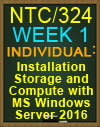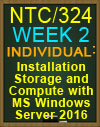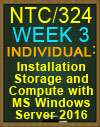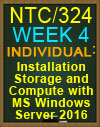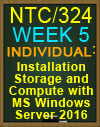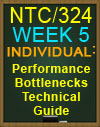NTC/324 Windows Server
Configuration |
|
|
|
|
|
|
NTC/324 Week 1
Everything listed for Week 1 is Included in Purchase! A+ Work!
Individual: Installation Storage and Compute with Microsoft Windows
Server 2016 Lab Report
Instructions:
Submit your Microsoft Word documents for the following Practice Labs
to the Assignment Files tab:
• "Install Server Core"
• "Install Windows Server 2016"
• "Configuring and Managing Nano Server"
• "Working with Microsoft Assessment and Planning"
• "Maintaining Operating System Images using DISM"
• "Managing Operating System Images with Windows Deployment
Services"
|
|
|
|
|
NTC/324 Week 2
Everything listed for Week 2 is Included in Purchase! A+ Work!
Individual: Installation Storage and Compute with Microsoft Windows
Server 2016 Lab Report
Instructions:
Submit your Microsoft Word documents for the following Practice Labs
to the Assignment Files tab:
• "Managing Local Storage and Virtual Hard Disks"
• "Implementing Storage Pools"
• "Configuring SMB and NFS File Shares"
• "Managing iSCSI Storage"
• "Installing and Configuring Data Deduplication"
• "Implementing Centralized Event Logs"
|
|
|
|
|
NTC/324 Week 3
Everything listed for Week 3 is Included in Purchase! A+ Work!
Individual: Installation Storage and Compute with Microsoft Windows
Server 2016 Lab Report
Instructions:
Submit your Microsoft Word documents for the following Practice Labs
to the Assignment Files tab:
• "Enabling Nested Virtualization"
• "Managing Virtual Machine Settings"
• "Managing Virtual Machine Storage"
• "Managing Virtual Machine Networks"
Individual: Create Hyper-V VHD and VHDX Virtual Drives
Instructions:
A virtual disk is a type of disk drive that works like a physical hard disk
and is used by computer virtualization applications. Windows Server
2016 Hyper-V supports two virtual hard disk formats: VHD and VHDX.
Using the Practice Labs environment setup in the lab "Managing Virtual
Machine Storage," create two virtual hard drives using the following
settings:
Disk 1:
• Virtual Disk: <YourLastName1>
• Disk Format: VHD
• Disk Type: Fixed size
• File name: <YourLastName1.vhd>
• Size: <Choose an appropriate size>
Disk 2:
• Virtual Disk: <YourLastName2>
• Disk Format: VHDX
• Disk Type: Dynamically expanding
• File name: <YourLastName2.vhdx>
• Size: <Choose an appropriate size>
Paste a screenshot of your final screens into a Microsoft Word
document.
Name the Microsoft Word document, "<Your Name> Virtual Disk
Creation Lab Results Week Three".
Submit your Word document to the Assignment Files tab.
|
|
|
|
|
NTC/324 Week 4
Everything listed for Week 4 is Included in Purchase! A+ Work!
Individual: Installation Storage and Compute with Microsoft Windows
Server 2016 Lab Report
Instructions:
Submit your Microsoft Word documents for the following Practice Labs
to the Assignment Files tab:
• "Implementing Hyper-V Replica"
• "Managing Hyper-V Fault Tolerance using Failover Clustering"
• "Implementing Failover Clustering for Scale-out File Servers"
• "Managing Virtual Machine Movement"
• "Install and Configure Network Load Balancing"
Individual: Failover Clustering Fault Tolerance Technical Guide
Instructions:
A failover cluster is a group of independent computers that work
together to enhance the availability of applications and services.
Failover clusters provide the fault tolerance and high availability of
network services. If one of the nodes in the cluster fails, the other node
takes over and begins to provide the service - a process known as
failover.
Using the Practice Lab "Managing Hyper-V Fault Tolerance Using
Failover Clustering" as an example, create a 3- to 4-page technical
guide that documents each task for the following activities:
• Prepare system requirements for failover clustering
• Install and configure failover clustering
• Install virtual machine role on failover cluster
• Manage failover clustering
Include screenshots of the successful execution of each of the above
activities. Your technical guide should not only document how to
accomplish each of the above tasks, but should also document, with
screenshots, the successful completion of each of the tasks in the
Microsoft Windows Server 2016 Practice Labs environment.
Submit your technical guide to the Assignment Files tab.
|
|
|
|
|
NTC/324 - Week 5
Everything listed for Week 5 is Included in Purchase! A+ Work!
Individual: Installation Storage and Compute with Microsoft Windows
Server 2016 Lab Report
Instructions:
Submit your Microsoft Word documents for the following Practice Labs
to the Assignment Files tab:
• "Managing Server Performance"
• "Implement Windows Server Update Services"
Individual: Performance Bottlenecks Technical Guide
Instructions:
Bottlenecks happen when a computer resource (CPU, disk, memory,
network interface, and/or process) reaches its capacity, causing the
performance of the entire system to slow down. Bottlenecks are usually
caused by insufficient or misconfigured resources or faulty system
components and frequent requests for resources by an application.
Rerun the section "Detecting System Bottlenecks" of the Practice Lab "Managing Server Performance."
Complete the tasks for "Download Tools to Create System Bottlenecks"
and "Create System Bottlenecks in CPU."
Using the information from the lab and your observations, create a 2- to
3-page technical guide. In this guide, discuss how performance
bottlenecks occur in the Windows Server® 2016 operating system.
Identify what a system administrator can do to remove these
bottlenecks from the system and improve system performance. Also,
discuss how containers can be used to improve performance and
isolate environments in Windows Server® 2016.
Submit your technical guide document to the Assignment Files tab.
|
